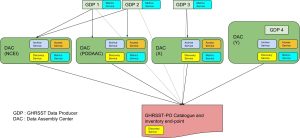The Group for High Resolution Sea Surface Temperature (GHRSST) is an open international science group that
- coordinates research and operational developments in satellite-derived sea surface temperature (SST)
- promotes the application of satellites for monitoring SST by enabling SST data producers, users and scientists to collaborate within an agreed framework of best practices
- provides a framework for SST data sharing, best practices for data processing and a forum for scientific dialogue, bringing satellite-derived SST to the users.
GHRSST has been extremely successful in revolutionising the way satellite SST data sets are developed, shared, and applied in modern oceanography, meteorology, and climate centres. Success is achieved by solving scientific, operational, and technical problems and also by cooperation at an international level to agree on data product definitions and standards that are acceptable to users, producers, and data managers.
GHRSST coordinates and conducts research, establishes procedures and protocols, provides near real-time data access portals and user services, and implements near real-time quality control monitoring services. Large volumes of data and data services are harnessed together to deliver the new generation of global coverage high-resolution SST data thereby meeting GHRSST User Requirements.
A new framework for GHRSST (formatted) data provision
GHRSST pioneered a Regional/Global Task Sharing Framework (R/GTS) which uses a scientifically and technically feasible strategy to acquire existing SST data products, add additional information and create a new generation of products in a common format.
The first GHRSST products were made available in 2005: under the R/GTS, data produced by Regional Data Assembly Centres (RDACs) were ingested by a Global Data Assembly Centre (GDAC) and publically distributed via various services. The final archiving and further distribution were performed by the Long-term Stewardship and Reanalysis Facility (LTSRF). The original system has grown more complex with the addition of more DACs and data producers over the years.
A new system, with decentralisation of data ingestion and distribution, was designed in 2022 to prepare GHRSST for future growth and facilitate the integration of new data producers. The new framework is illustrated below and is extensively described in the “GHRSST R/G TS System Architecture (GSA)” report.
In this new system, two entities are involved:
- Data producers (GDPs) and
- Distributing centres (DACs).

Figure above: The GHRSST Regional/Global Task Sharing (R/GTS) Framework
Each DAC implements a minimum set of services for granule data access, search and discovery, production/distribution metrics and long-term archiving.
The GHRSST Central Catalogue is hosted on the GHRSST website and functions as a central catalogue for all GHRSST datasets with a collection of level metadata, and federated search and discovery services. The Central Catalogue portal allows SST users to discover and search all GHRSST products and granules with no need to know the data producer or distributor.
All DACs have agreed to provide metadata to the Central Catalogue. The DACs’ level of readiness to provide data access (HTTP(S), FTP, THREDDS, and OpeNDAP) and granule search (OpenSearch) services has been verified. Most of the DACs are able to provide HTTP(S) and OpenSearch services.
The implementation of the Central Catalogue was initiated in 2022, supported by EUMETSAT and was funded by the European Union Copernicus Programme. The setup will be completed in 2023 after a beta testing phase. The Central Catalogue is maintained by the GHRSST Project Office (GPO).
Resources:
- GHRSST website section for SST data producers
- GHRSST website section for SST data users
